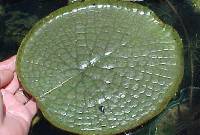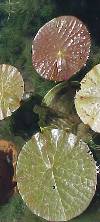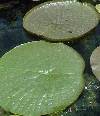Our Adventure With Victoria 2004
This section of the web site reviews
each year of our adventure, with details not found in other sections
of the site -- things like plant and flower numbers, successes
and failures, big and small things we've learned. It also discusses
thing we want to do, things we want to know, things we speculate
about. It is sequential, often with questions raised one year
answered the next. We don't go back and rewrite. Index

Click images to enlarge
When we first began with Victoria, there were so many problems involved with growing it that pure luck provided the greatest chance of success. Over time we seem to have improved the proper temperatures for storage of each type individually. We have learned that removing the operculum from the seeds of difficult lots improves germination dramatically. We have found the combination of factors that promotes seedling survival.
In short, we have eliminated enough variables and accumulated enough data that we can begin to look at sprouting and survival patterns group to group. There are some surprising similarities and some baffling differences.
With V. amazonica, all stock that we deal with has been provided to us from recent collections in the wild so we are sure it is pure. We feel patterns can be viewed as representative, at least for the region of Amazonia from which they were collected.
For V. cruziana, we now look at them in two separate groups. The domestics, more or less of known provenance, have not been tracked as carefully as we would like prior to our receiving them and we again mention the possibility of corruption somewhere in their 100 year history in cultivation. The second group is the wild-collected. Our experience with the Paraguayans now spans enough years that patterns are taking shape. Preliminary data on the Argentinians seems to match.
The experience described above leads us to speculate about the possibility of a built-in germination trigger. It is not surprising that crosses of the species would be stronger than selfs. What is surprising is that amazonica and wild cruziana seem to follow the same patterns, crosses sprouting early on and selfs sprouting several years later. This is contrary to our experience with domestic cruziana.
We know little about pollinators of cruziana in the wild. None were observed by Walter Pagels, Jorge Monteverde and Butch Weaver on their trips. What if many, if not most, seeds in any given pod are selfs, engineered to germinate several years later if the population of crosses (limited but vigorous) is threatened?
Much has been observed and written about the beetle pollinators in Amazonia and there has long been a presumption that many, if not most, seeds in an amazonica pod are crosses. This could account for the early and flurry germination of wild (presumably crossed) seeds and cultivated crossed seeds. The weaker selfs are held in reserve for emergencies in the wild and are more difficult in cultivation.
The primary hybrids add their own interesting patterns. Most, though not all, lots of 'Longwood Hybrid' sprout at nearly 100%. Very few 'Adventure' seeds sprout spontaneously. Some sprout after nicking but the best results are obtained after a second nicking. Seedlings of both hybrids are stronger than either species with 'Adventure's' survival rate even higher than Longwood's. Longwood must have the "sprout gene" and 'Adventure' the "don't sprout gene". As a side note, Longwoods with wild and domestic cruziana parents sprout equally well. 'Adventures' sprout equally poorly.
The back-cross hybrids 'Challenger' and 'Columbia' (3/4 cruziana) don't sprout at all well unless nicked but seedlings are very strong. 'Atlantis' and 'Discovery' (3/4 amazonica) sprout nearly as well as 'Longwood Hybrid' and seedlings are vigorous. Though we no longer produce selfed seeds (F2s) of the primary hybrids, in past years when we did so, germination was high for both 'Adventure' F2 and 'Longwood Hybrid' F2 but not as high as for 'Longwood Hybrid' itself. Though our information about subsequent generations is limited, we think that sprout rate as well as seedling vigor would drop with each selfed generation, consistent with other selfs.
The domestic cruziana sprouting patterns almost have to be ignored for our other observations to make any sense. As has been suggested before, we have either reprogrammed them in long cultivation or they have been corrupted somewhere along the line. DNA studies are in progress to determine which is true. The domestics don't fit what we are beginning to see as consistent and predictable patterns otherwise and perhaps have clouded observations of Victoria in general and cruziana in particular in the past.
Though it is extremely unlikely that Victoria will ever be high enough on the scientific study list to determine this, it would be very interesting to know if there is indeed a "sprout gene" and how it is passed on. For now we can only speculate, continue to collect data and guide our breeding program based on our best guesses of what the future holds.
Seeds of the Century | 2001 The Cruziana Clock | 2002 Crazy Cruziana
2003 A New Take On Victoria Species Germination &
Will The Real cruziana Please Stand Up


